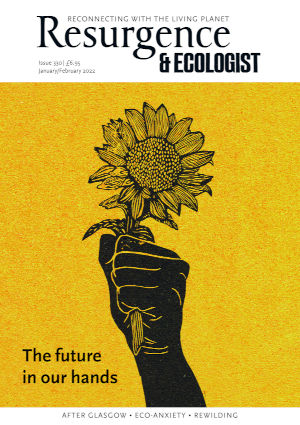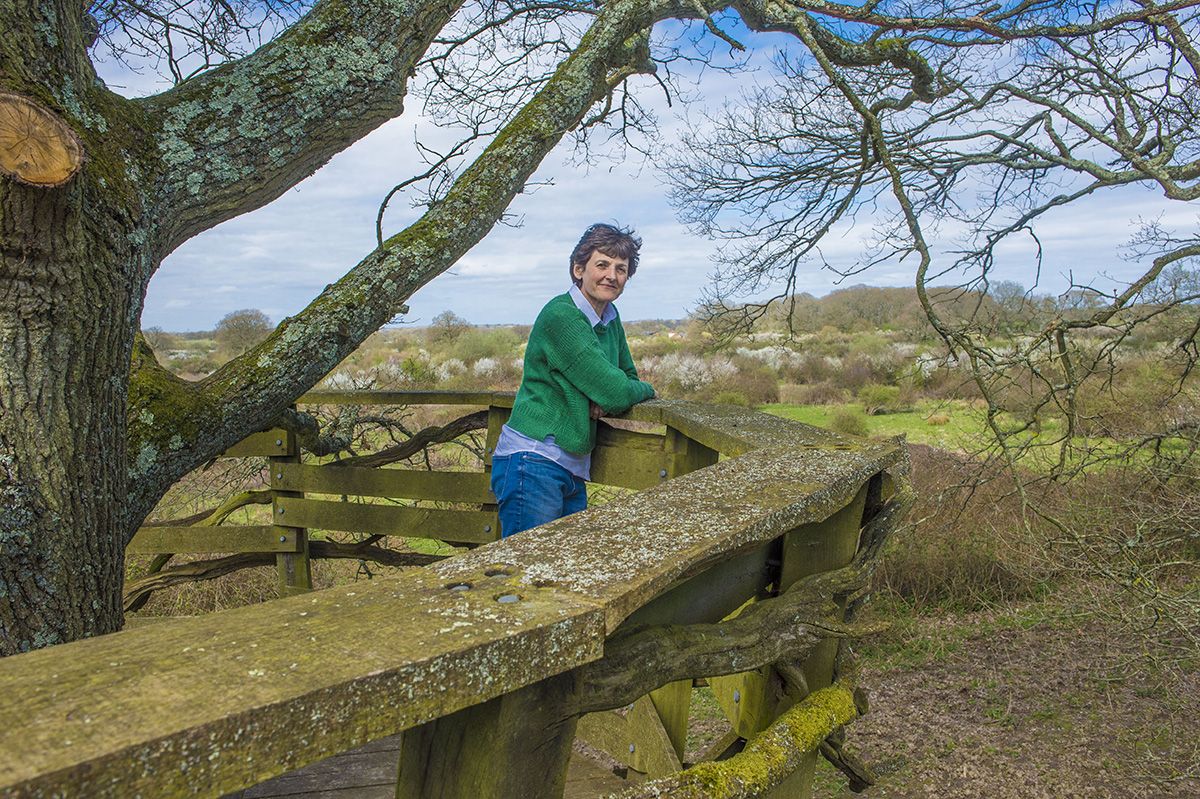When Isabella Tree and her husband Charlie Burrell embarked on what would become the UK’s shining example of rewilding, they had no idea what the future held. Though they have been dubbed ‘the King and Queen of Rewilding’, Tree remains exceptionally humble as she describes the dramatic transformation they witnessed on their West Sussex farmland. “I don’t think we can really take much credit for it,” she says. “We had hit the buffers with farming, and we wanted to work with the land rather than battling against it. Nature just did its thing on our land.”
The story of Knepp Estate and its rapid evolution from unprofitable agricultural land to a rewilded landscape teeming with endangered species is chronicled in Tree’s prize-winning best-seller, Wilding. It tells how the couple handed their 1,400 hectares of farmland back to Nature: ripping out fences, abandoning the use of pesticides, and introducing free-roaming herds of animals.
“The book was really about the astonishing resurgence of Nature,” Tree explains. “That was beyond any of our imaginings, and even the scientists on our advisory board couldn’t believe the pace of change and uplift of biodiversity.” Wilding ends on this note of hope for the sheer power of Nature to revitalise and recover when given the space. But I’m curious to learn what Tree has been focusing on at Knepp since the book was published three years ago.
Successful though their rewilding project has been, Tree says, she’s aware that Knepp on its own is an island. The density and variety of species within Knepp cannot spill out and colonise, because there is a dearth of high-value habitat surrounding the estate. “We now have this incredible biodiversity hotspot, but we’re living in a bubble,” Tree admits. “It was a beautiful place to be for lockdown, but whenever we leave this bubble, we’re hit by the desertification of the land around us.”
Their focus now is on collaborating with neighbours on the vision to connect Knepp. One such project focuses on linking Knepp to the sea, while another looks northward to areas such as St Leonard’s Forest and Ashdown Forest. The aim is to connect Knepp with different Nature-rich environments and habitats – from heathland to heavy clay to chalk to salt marsh – thus creating a significant ecosystem with natural processes flowing through the landscape on a large scale.
This next stage of Knepp’s evolution involves talking with landowners and farmers about what they can do to connect areas of biodiversity: perhaps allowing hedgerows to grow out as buffers, reducing their pesticides or even considering regenerative farming. “Obviously, these farmers aren’t going to want to rewild the whole of their land,” Tree says. “Some are on very profitable farmland, and we don’t want that either: we need land for agriculture. It should be the best land, obviously, rather than marginal land like ours. But there are ways of leaving some areas for Nature within that patchwork.”
Tree’s goal of connecting Knepp to a wider Nature-full landscape has been threatened in the past year by controversial development plans for 3,500 houses on a greenfield site right on the border of Knepp. Tree admits that a year ago they were full of despondency, with the council having seemingly made up its mind already. However, she shares the encouraging news that just recently all building plans in the district have been put on hold due to an edict by Natural England that developments will only be approved if water neutrality can be demonstrated.
The area around Knepp also has an additional level of protection, provided by an unlikely hero: a 5mm-tall mollusc called the little whirlpool ramshorn snail. Thanks to the charity Buglife, this snail is protected by international law. Natural England has flagged that extracting any more water from Knepp’s catchment could threaten the snail, thus putting the brakes on any development plans. “There’s an amazing David and Goliath story going on here,” Tree tells me happily.
Tree hopes that society is beginning to move away from the ‘build, build, build’ mentality of the past decade, a mantra she describes as “very much old school” yet still embedded at local government level. Instead, she says, we are heading towards a new type of thinking: one that focuses on Nature recovery, regenerative agriculture, connectivity, and thinking together.
“I think things are beginning to shift,” she says. “I wonder if it is partly due to COP[26], and partly because people are slowly beginning to understand that, actually, this is serious. Nature recovery isn’t just the icing on the cake. It is something you do wherever possible, wherever there’s space to do so, and something at the heart of government policy. So that’s what we hope the trajectory of travel is.”
In order to help people take full advantage of any space available, Tree is currently writing a ‘book of wilding’: a rewilding handbook of sorts. Initially envisaged as a small pocketbook one might take out on a walk, it has since, Tree tells me, “rewilded itself, and turned into a hairy, uncontrollable, ravening monster” – so it might be a few pages longer than planned. The essence remains the same, however. After the success of Wilding, Tree was inundated with an incredible response from the public reacting to the story of hope that Knepp represents. People wanted to know how they could replicate what was happening at Knepp on their own land.
Tree is very clear that you do not need to own 1,400 hectares – or even one hectare – to make use of the book of wilding. In fact, there will be an entire chapter devoted to rewilding cities. “Whatever little piece of soil we have jurisdiction or stewardship over, we can do something positive with it,” she says.
She explains that the smaller the land, the more human intervention is needed to replicate the natural processes that are missing, because of the constraints of space – which is where the handbook comes in. Tree hopes that having accessible rewilding advice between the covers of a book will help people to think practically about how they can contribute to a webbing of Nature restoration throughout the landscape.
“It goes back again to this theme that seems to be possessing us at the moment, which is connectivity. If you have a back garden, you can persuade your neighbours to cut a hole in the fence or hedgerow, and that becomes a hedgehog highway. If everyone in the street goes pesticide- and herbicide-free, and perhaps one person can have a pond, another a beetle bank, then suddenly you’ve got a chain of habitats that becomes really significant.”
Although there is still a long way to go to realise the interconnected landscape she envisions, Tree is hopeful that society is moving in the right direction. “Twenty years ago rewilding was a dirty word,” she laughs. “You couldn’t have said it without people’s hackles rising. But now it’s mainstream.” Knepp may have led the way, but it is no longer alone on the rewilding scene by any means.
Grassroots Level
In May 2021, Inkcap Journal published an investigation revealing that a quarter of local councils in England have plans to rewild. I asked Isabella Tree what she thought local authorities could be doing to aid Nature recovery.
For a start, she suggests that local councils have an ecologist as part of their team so that they truly understand how Nature works: how green space can properly function in towns, how a wildflower meadow is created and maintained, and why they should consider leaving road verges unmown.
She also has big hopes for the Environment Bill and its inclusion of local Nature recovery strategies. Tree believes these are a critical framework for improving connections between high-value Nature areas in different districts and working towards a national network. Without proper connection, isolated Nature reserves and biodiversity hotspots like rewilding projects will begin to struggle with issues such as genetic inbreeding, she explains – but a designated recovery network could give species the flexibility and space they need to bounce back.
Tree would also like to see closer relationships between environmental organisations and councils. Ultimately, however, she points out, change needs to start at grassroots level and it is up to the people who elect councillors to demand the right thing by Nature. “There’s lots of things happening around us [at Knepp], lots of villages beginning to think green and go pesticide-free, so change is happening – but I would love to see it gather even more momentum and become unstoppable.”







